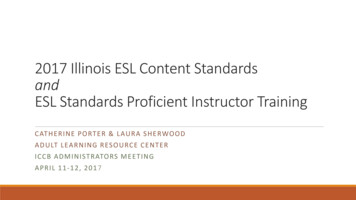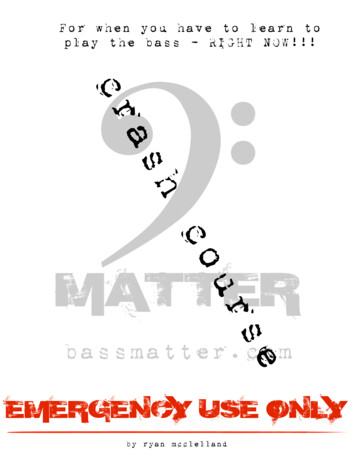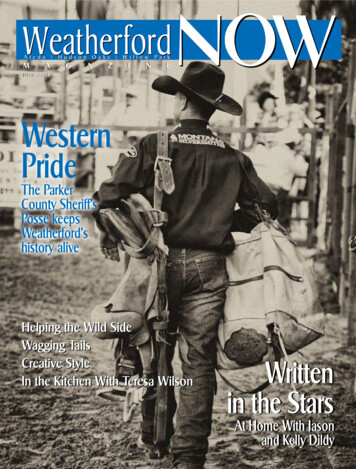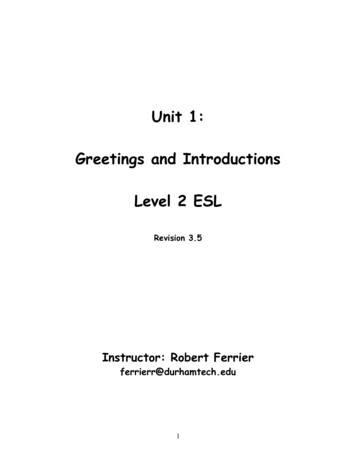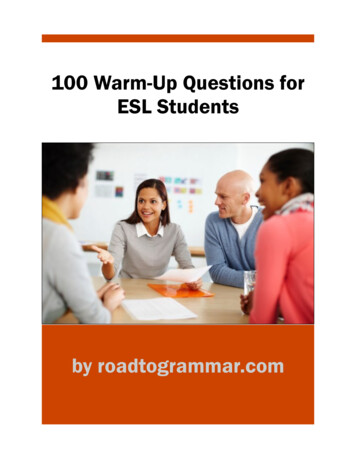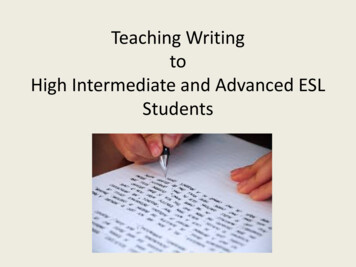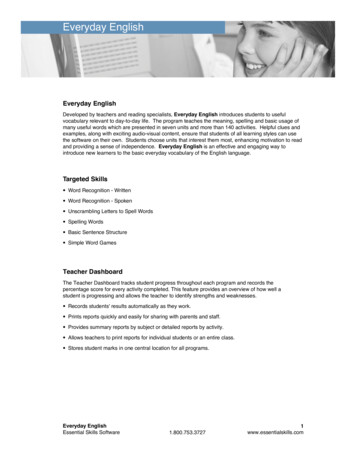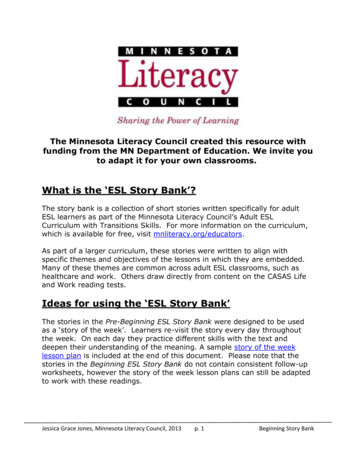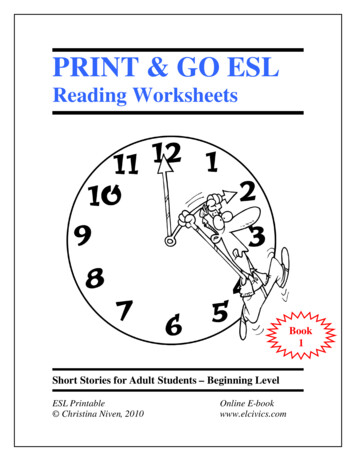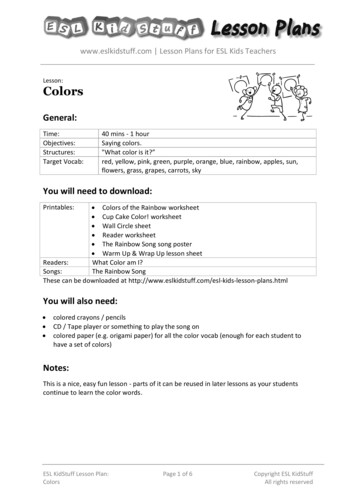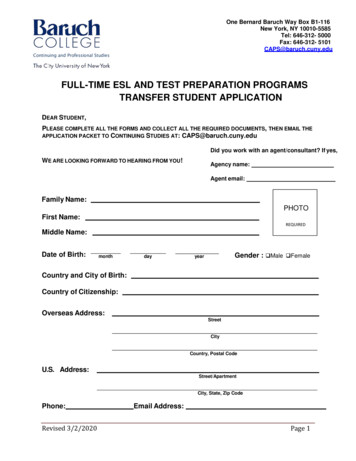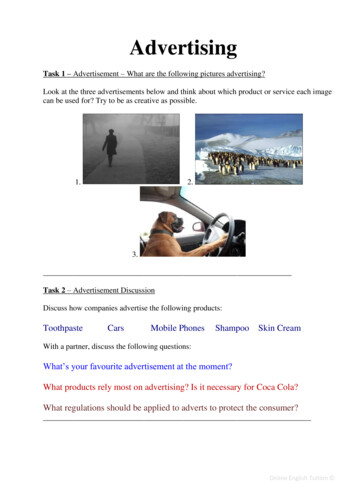
Transcription
AdvertisingTask 1 – Advertisement – What are the following pictures advertising?Look at the three advertisements below and think about which product or service each imagecan be used for? Try to be as creative as possible.1.2.3.Task 2 – Advertisement DiscussionDiscuss how companies advertise the following products:ToothpasteCarsMobile PhonesShampooSkin CreamWith a partner, discuss the following questions:What’s your favourite advertisement at the moment?What products rely most on advertising? Is it necessary for Coca Cola?What regulations should be applied to adverts to protect the consumer?Online English Tuition
Task 3 – Advertisement VocabularyFind the following vocabulary in the picture below:SloganLogoBrand NameImagePosterCheck the meaning of the underlined words with a partner, then answer each question about CocaCola together as best as you can.Who is the target audience of this product?Can you describe their one of their previous advertising campaigns in your country?What is the price range of their product in your country?What do you think the total sales figures were for Coca Cola last year?What do you usually see in the advert?Task 4 – an effective advert?Watch the following advert by Coca Cola. https://www.youtube.com/watch?v ogetBqMgau0Make a note of the following:1. What is good and bad about the advert?2. What advertising techniques do they useOnline English Tuition
Company 1NameCompany 2Company 3PopFizzCBD (Carbonated Bio Drink)Breakfast BeverageTokyo, Japan in 2008San Francisco, California in 2004Rio de Janeiro, Brazil in 2011Specialises in carbonated drinks. It is fifthbiggest soft drinks manufacturer in Japanand it has branches in South Korea andChinaIs a certified 100% organic energy drink.They have a range of flavours all madefrom a secret bio recipe. Have 0.3% sharein US market and 1% in Germany.Specialises in breakfast juice drinks, madefrom 100% fruit with no added sugar.Have a colourful brand image and theirdrinks are sold solely in Brazil.PopFizz Orange allows the consumer tobecome more “intelligent” for about 15minutes. It contains the chemical, PlaceboX,which, as studies show, allows the brain tounlock previously stored information, whichallows the consumer to remember thingsthey had previously forgotten.Being completely organic, it doesn’tcontain artificial sweeteners,preservatives or synthetic caffeine.Instead, it uses ingredients such asorganic Ginkgo Biloba and Ginseng, twonatural ingredients of the plant family.The energy is released slowly throughoutthe day, avoiding the sudden high and“crash” of other energy drinks.Considered by experts to be the mostnatural juice drink on the market. It ishigh in vitamin C and fibre and low incalories. The unique taste is said to giveyou a “kick” in the morning and jumpstart your day. One glass contains theequivalent of 3 pieces of fruit, more thanhalf of the daily recommendedallowance.Company revenueThe company generated 10 million netprofit in 2011.The company generated 1.3 million netprofit in 2011.The company generated just 160,000net profit in 2011.Aims for the futureThey want to expand into the European andAmericas markets. They are prepared tospend 1 million on advertising in theseregions. They want people to know theproduct comes from Japan. They would liketo use a celebrity to endorse the product.Hopes to become the leading energydrink in the U.S and Europe. Theiradvertising has been mainly on local TVnetworks, but they are searching for newplatforms to advertise on. Their productappeals to all age groups.Wants to become the most popularbreakfast drink in the world! They hopeto reflect the colourful, Brazilian drink intheir advertising and highlight the healthbenefits of it. They need to develop acatchy brand slogan and image to winmore customers.FoundedProduct InformationUSP (Unique Selling Point)Online English Tuition
Unsuccessful Advertising CampaignsLifeLock is an identity theft prevention company that detects fraudulentapplications for credit cards, mortgages and car loans placed in their clients’names.LifeLock CEO Todd Davis was so confident in the company’s ability toprotect sensitive information that it publicized its services with a televisionadvertisement, in which a van drives by with his real, actual social securitynumber illustrated on the side, all but daring criminals to use it.A number of identity thieves not only took the dare, but used theinformation successfully multiple times. In two cases reported in thePhoenix New Times, a Texas man used the social security number to takeout a 500 loan and another in Georgia used the CEO’s information to openan AT&T wireless account. Davis knew nothing about either instance untilthe collection agencies started calling him.The Plan: Market the Renault by drawing on its similarities to pears, sincethey’re kind of the same shapeThe Story: Deciding that likening an ugly car to an ugly fruit was a goodidea, French automaker Renault tried to launch a campaign that comparedthe Renault 14 to a pear. The fact that “poire,” in French, can mean bothpear and gullible was apparently lost completely on the manufacturers, aswas the fact that no one really wants a car that looks like a pear. On top ofthis, the car had an issue with body corrosion, leading people to startcalling it “the rotten pear.”We start the list with the single most recognizable product in the world:Coca-Cola. There is the old saying, “if it ain’t broke, don’t fix it.” Well, theCEO at Coke probably never heard this saying when he decided to switchits old formula and create a new one to compete with Pepsi’s extremelysuccessful “New Generation” ad campaign in 1984. If the original name,“New Coke,” was bad enough, they changed it to “Coke II” when it wasreleased to the supermarkets, as if it was a bad sequel to a Keanu Reevesmovie.The reception of this new Coke was negative, to say the least. Here is anumber: 400,000. That is the number of letters and phone calls received byCoke in first couple of weeks, criticising the new product. This is 1985,when you had to go to the trouble of handwriting and sending a stampedletterNeedless to say, Coca-Cola rebranded the product “Coke Classic” in 1985and sold more than New Coke and Pepsi combined.Online English Tuition
Answer Key – AdvertisingTask 3 – Advertisement VocabularyPosterSloganLogoBrand NameImageWho is the target audience of this product?It has a big target audience. One market is teenagers as their adverts usually feature young,trendy, cool people. They sponsor many sports teams and events, appealing to the sport fanmarket. Coca Cola also featured a businessman in one of their adverts, promoting coke as thedrink of the business lunch.Can you describe their one of their previous advertising campaigns?The participants will be able to give a lot of examples. Perhaps the most famous is theChristmas advert “Holidays are coming” and the numerous celebrity endorsements ofChristina Aguilera, 50 Cent and Wayne Rooney.What is the price range of their product in your country?N/A – Participants will provide the answerWhat do you think the total sales figures were for Coca Cola last year?If you are using this worksheet from 2012 onwards, you need to research the exact figure. In2010, coca cola revenue amounted to 31 billionWhat do you usually see in the advert?Coca Cola has a wide range of adverts which include young, trendy people often taking part inhigh energy activities and celebrity endorsements. The adverts typically feature a coolrefreshing image of the drink, usually being opened with the contents slowing out. Naturally,you will also see people drinking it.Advertising Lesson Plan – Teacher’s NotesDesigned to elicit your participant’s creative side, this lesson focuses on communication andreading. The participants look at a variety of tasks related to advertising and then create their ownadvertising campaign at the end of the lesson.Online English Tuition
Important Information:Aim: to improve participant’s speaking and increase their terminology of advertising languageLevel: Intermediate, Upper-Intermediate and Advanced.Length of Lesson: minimum 2 hours (can be longer with “creating an advert” activity)Number of Participants required: Any numberLesson Plan Stages1) Begin the lesson by writing the following slogans on the board:“I’m loving it” “Just do it” and “iThink therefore iMac”Ask the participants if they know what these phrases are (Slogans) and which companiesthey are associated with (McDonalds, Nike and Apple). Then ask the participants to consider(in pairs or as a group):a. Why do companies use slogans? – a phrase the company wishes to be known byb. What makes a good slogan? – makes consumer feel a desire, witty, hard to forgetHand out the first page and ask the participants to look at task 1. Tell them to look at eachpicture and in pairs or small groups, decide what the product or service each picture isadvertising and how the picture is used in the advert. As a secondary task, ask theparticipants to come up with a slogan for each picture. This should take about 10 minutes.Encourage the participants to be as creative as possible.These are not real adverts so there are no real answers, but it’s great to hear theparticipant’s ideas.Review the answers as a class and correct language mistakes where necessary. Ask follow upquestions on humorous suggestions to encourage more participant talk time.2) Ask the participants to discuss the questions in task 2. It encourages them to think about thestructure of adverts and how different advert methods are used for different products. Holdclass feedback where necessary and correct language errors.3) On the board, write the heading “Unsuccessful advertising campaigns.” Then write thefollowing phrases on the board under the heading.NoVa – Car Company actual translation “Doesn’t Go” in SpanishEviteEmbarazos – Parker Pen Company actual translation avoid pregnancy in SpanishPavian – Bacardi (Rum company)actual translation Baboon in GermanIf you have any Spanish speakers in the class (1 and 2) or German speakers (3) ask them to explainwhy these were unsuccessful phrases to use in advertising or ask the participants to predict whythese were not successful, you are not looking for exact reasons but potential problem areas.Online English Tuition
Hand out the reading text entitled “Unsuccessful Advertising Campaigns” to the participants. Tellthem they are going to read about 3 unsuccessful advertising campaigns in business.a. Participants read through once and make a small summary (3 – 4 sentences) about each mistake.They then work in groups of 3 and each participant explains 1 text.b. Participants then read the three texts again and answer the following questions (you can writethese on the board or make a separate worksheet):Questions 1 and 2 apply to text one, 3 applies to text two and 4 and 5 apply to text three.1. Why did Todd Davis use his real social security number on the side of the van?A: He was so confident no one would steal it2. What problems did Todd Davis have with identity thieves?A: One person took out a 500 loan in his name and another set up an At&T account3. What two things did the manufacturers of the Renault 14 not consider?A: a. That the word “poire” means gullible and b. no one wanted a pear shaped car4. What does the phrase “If it ain’t broke, don’t fix it mean?”A: If something is successful and working well, don’t change it5. How did coke correct the mistake of New Coke?it rebranded it to Classic Coke4) In pairs, the participants then work on task 3 – vocabulary exercise. Feedback can be done on theboard (with the picture projected or stuck on). The participants then answer the questions aboutCoca Cola in the same pairs. The answers to these task 3 can be found in the Answer Key.5) Discuss the final question in task 3 “What do you usually see in the advert?” as a group. Elicitanswers from the participants and then load the video. (Task 4 is best done when access to YouTubeis easy to access, if you must carry a laptop to the lesson, perhaps its best to skip to step 5). Play theclip and ask students to make notes on the two questions. Discuss as a class and correct thelanguage where necessary.6) Creating and Advertising Campaign activity. The Participants will now create their own advertisingcampaign. The set up to this activity can be done one of two ways:1. Hand out the table to the participants and group them into 3’s. Each participant read about 1company and explains it to the other participants.2. Hand out the table and read through each company as a class, asking one participant to read outlate one company.Ask the participants at this stage to ask about any unknown words in the descriptions.NB.: All three companies aren’t real.Once each company has been read and understood, group the participants into three or four (forone to one lessons, the participant can work on their own using the teacher as a sound board fortheir ideas).Online English Tuition
I have two methods for the next step1. Assign the participants a company, so that each company is presented(I feel this gets the participant talking about different things).2. Let the participants chose the company they want to design an advert for(In my experience, this tends to make participants more motivated).The choice is yoursThe participants work together to develop an advertising campaign. Tell them they will create a 1minute advert to appear on TV and a poster to appear on billboards to advertise the product andthen present their ideas to the class.For the presentations, use what you have your disposal. A3 paper and marker pens or computers willhelp to liven up the presentations.To help the participants with the basic ideas of the advert, write the following criteria on the board:Target MarketSloganBrand ImageLogoThis will especially help the billboard advert.The participants then discuss what happens in the TV advert, encour
Advertising Lesson Plan – Teacher’s Notes Designed to elicit your participant’s creative side, this lesson focuses on communication and reading. The participants look at a variety of tasks related to advertising and then create their own advertising campaign at the end of File Size: 552KBPage Count: 8
